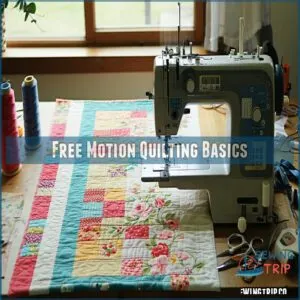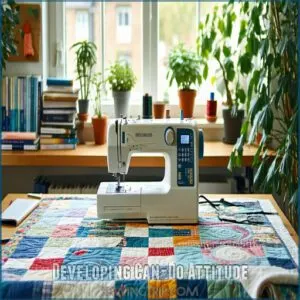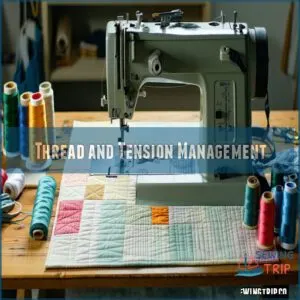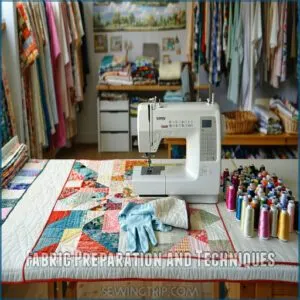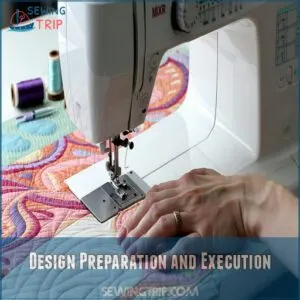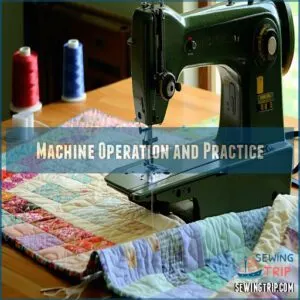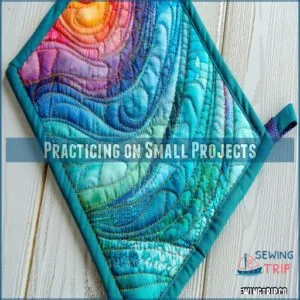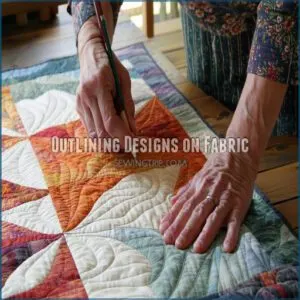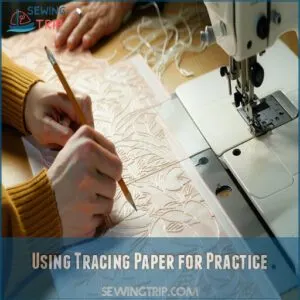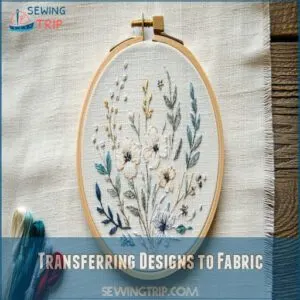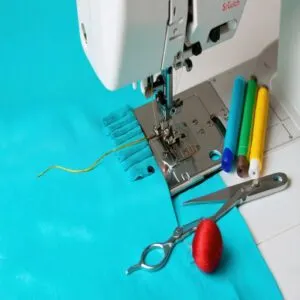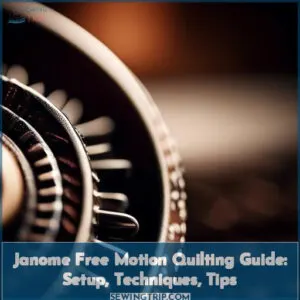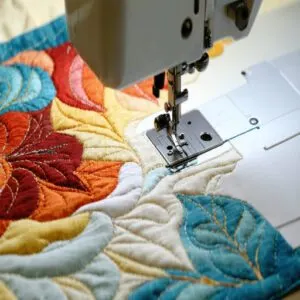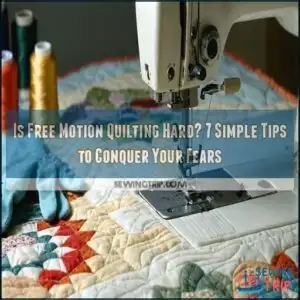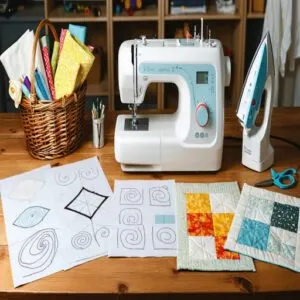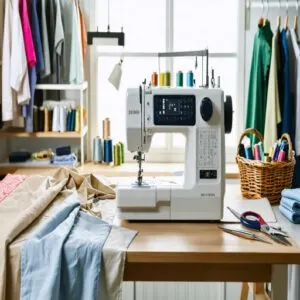This site is supported by our readers. We may earn a commission, at no cost to you, if you purchase through links.
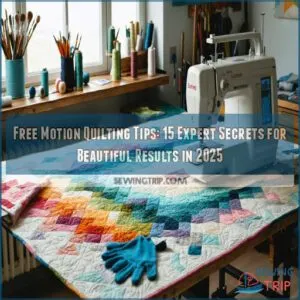 Free motion quilting success starts with the basics: lower your feed dogs, grab a reliable free motion foot, and manage your thread tension.
Free motion quilting success starts with the basics: lower your feed dogs, grab a reliable free motion foot, and manage your thread tension.
Steady fabric control is everything—practice moving your quilt sandwich smoothly while balancing your machine’s speed. Gloves can improve your grip, while a Supreme Slider reduces drag like magic.
Plan your design ahead—sketch it out or mark it on fabric to avoid guesswork mid-project. Troubleshooting uneven stitches? Adjust your tension or try a forgiving pattern like stippling.
Remember, consistent practice builds confidence. From tools to technique, the right know-how makes quilting feel less like work and more like freedom.
Table Of Contents
Key Takeaways
- Lower your feed dogs and use a free motion foot to control fabric movement smoothly while mastering consistent stitches.
- Adjust thread tension and experiment with threads to avoid issues like puckering or eyelashing during quilting.
- Start with small projects like potholders to practice fabric handling, design control, and stitch regulation.
- Plan your quilting designs by sketching or marking on fabric to prevent guesswork and improve precision.
Free Motion Quilting Basics
You’ll discover how to transform your quilting by lowering your machine’s feed dogs and using a specialized free motion foot that lets you control the fabric’s movement.
Once you’ve mastered these fundamentals, you’ll create beautiful patterns by guiding your quilt sandwich while your machine simply powers the needle up and down.
Lowering Feed Dogs
Before you start free motion quilting, locate your feed dog control – it’s usually a switch or lever on your machine’s base.
You’ll need to lower these metal teeth completely to allow smooth fabric flow during quilting.
When feed dogs are disengaged, you’re in control of the quilt’s movement, which is essential for creating those beautiful, flowing designs you’ve been dreaming about.
Using Free Motion Foot
Your free motion quilting foot serves as your trusty sidekick for achieving those perfect stitches.
Investing in quality quilting tools is essential for best results.
You’ll need a specialized foot that’s compatible with your machine’s make and model. For best stitch quality, guarantee proper foot adjustment by following your machine’s manual.
The foot should hover slightly above the fabric, allowing smooth movement while maintaining consistent tension.
Most brands offer dedicated free motion feet designed specifically for quilting.
Controlling Fabric Movement
Mastering fabric movement is key to free motion quilting. You’re in charge of guiding the quilt smoothly—think of it as steering a car.
- Control weight and direction with both hands.
- Use consistent speed management for even stitches.
- Adjust thread tension to prevent puckering.
- Practice stitch regulation on scraps.
- Keep the quilt sandwich flat for better results.
Creating Quilting Patterns
Creating quilting patterns lets you bring your vision to life.
Start with simple free motion quilting designs like loops or a stipple quilting design. Experiment with quilt motifs and stitch variations to add texture. Match your fabric choices and color schemes to enhance the design.
Practice these free motion quilting ideas to refine your skills.
| Technique | Description |
|---|---|
| Loops | Continuous, rounded shapes for texture. |
| Stipple Quilting | Meandering lines with no overlaps. |
| Echo Quilting | Repeating lines around a motif. |
| Feathers | Elegant, curved patterns for borders. |
| Grid Quilting | Straight lines for modern aesthetics. |
Essential Tools and Techniques
To master free motion quilting, you’ll need the right tools and techniques to make sure smooth, consistent results.
From managing thread tension to preparing fabric, each step plays an essential role, including managing thread tension.
Developing Can-Do Attitude
Feeling unsure about free motion quilting? A mindset shift is key. Approach each session with self-motivation and positive thinking.
Skill building takes time, but confidence grows with practice. Remember, even experts started as beginners.
Investing in a free motion tool can enhance your experience.
- Embrace imperfections as learning steps.
- Celebrate small wins.
- Keep a practice sandwich ready.
- Focus on progress, not perfection.
- Trust your ability to improve.
Thread and Tension Management
Thread weight and tension control are key for smooth stitches. Start with balanced upper thread tension and match bobbin thread weight.
Experiment with fiber selection, like 60-weight polyester thread, to reduce thread breakage. Practice basic motion beforehand to improve stitch consistency.
If loops or uneven stitch quality appear, adjust tension gradually. For free motion quilting thread, listen to your machine’s “sweet spot” to perfect speed and consistency, and achieve smooth stitches.
Fabric Preparation and Techniques
Proper fabric preparation sets the stage for smooth quilting. Start with clean, pressed fabric and choose batting that complements your project.
Use spray basting or pins for stabilization. Daily practice improves free-motion quilting, as highlighted in these free-motion quilting tips.
Quilting gloves improve grip, while a Supreme Slider reduces drag. Matching quilting threads in top and bobbin guarantees clean results.
These free motion quilting tips simplify machine quilting techniques for consistent stitches, ensuring a professional finish with proper fabric preparation.
Design Preparation and Execution
Once your fabric is prepped, map out quilting designs by sketching free motion quilting designs on paper.
Practice classic stippling or simple quilting designs to build confidence. Use fabric marking tools for stitch planning and design execution.
Explore available fabric marking tool options for various quilting needs.
Fill designs can add texture—try loops or swirls.
Remember, well-planned patterns make stitching smoother and help avoid mid-project guesswork.
Machine Operation and Practice
Mastering your machine’s operation is key to achieving smooth and consistent free motion quilting results. Practice controlling speed and fabric movement to build confidence and precision.
Setting Machine Speed
Choosing the right machine speed is essential for free motion quilting success.
Find your rhythm by experimenting with different speeds. A steady pace helps maintain stitch length and control.
Follow these steps:
- Start with medium speed.
- Gradually adjust for comfort.
- Sync hand movement with quilting pace.
- Use Speed Control for consistency.
- Always test Machine Calibration first.
To achieve ideal results, understanding sewing speed techniques is essential for efficient quilting.
Moving Quilt Sandwich Slowly
When free motion quilting, slow movement guarantees smooth glide and precise stitches.
Quilt control is key—guide the fabric steadily, adjusting your hands to maintain balance. Keep a steady pace, letting the machine’s speed complement your rhythm.
Quilting gloves can improve fabric handling, reducing strain. With feed dogs lowered, practice these free motion quilting techniques to master consistent, even results, and achieve a smooth steady pace.
Educating Oneself Through Classes
Building control while moving the quilt sandwich is tricky, but learning free motion quilting through classes can help.
Explore options like:
- Quilting Workshops: Hands-on sessions with teacher guidance.
- Online Tutorials: Flexible class schedules for skill building.
- Local Quilting Classes: Great for beginners needing direct feedback.
- Free Motion Quilting Tutorials: Perfect for refining techniques anytime.
Classes boost confidence and creativity!
Practicing Consistently
You’ve taken classes—now it’s time to practice daily.
Free motion quilting practice builds muscle memory and stitch control. Start with quilt samples to improve free motion quilting. Keep practicing small designs to master beginner free motion quilting.
Remember, skill building takes time, but consistency is key.
| Practice Tips | Why It Helps |
|---|---|
| Quilt small samples daily | Builds muscle memory |
| Focus on stitch control | Improves design consistency |
| Experiment with patterns | Boosts creativity |
Preparation and Practice Methods
Preparing for free motion quilting starts with the right materials and consistent practice. Focus on small projects and simple designs to build confidence and control.
Practicing on Small Projects
Starting with small projects like potholders or coasters is perfect for beginner free motion quilting. Focus on Quilt Sandwich Prep—secure layers with spray basting or pins.
Choose forgiving fabrics and threads to mask uneven stitches. Practice Exercises help build confidence; slow, steady stitching refines Thread Control.
These Small Project Tips make learning free motion quilting manageable and enjoyable while honing essential skills. Beginners can also benefit from using quilt starter kits to get started with their projects.
Outlining Designs on Fabric
Outlining quilting designs on fabric simplifies free motion stitching by providing clear stitch guidance.
Use fabric marking tools like chalk pencils or washable markers for pattern tracing. Draw directly on your quilt sandwich to visualize quilting designs.
This method guarantees smoother free motion quilting, helping you follow your planned quilt outlining with precision. It’s a game-changer for mastering intricate quilting patterns!
Using Tracing Paper for Practice
Grab tracing paper and sketch your quilt patterns to build muscle memory.
This paper practice refines stitch control as you trace repeatedly, mimicking free motion quilting.
Try designs from quilting tutorials or create your own.
These tracing techniques prepare your hands for real stitching, helping you master consistent movements while experimenting with intricate designs in a low-stress way, which ultimately aids in mastering consistent movements.
Transferring Designs to Fabric
Transferring designs to fabric is a game-changer in free motion quilting.
Use the right tools to mark confidently.
- Try quilting stencils or templates for consistent designs.
- Use tracing paper to outline before marking.
- Test a UNIQUE Sewing Washout Marker on scrap fabric.
- Pair fabric marking with proper lighting for precision.
- Always choose removable markers that won’t stain.
This approach ensures precision in your work.
Troubleshooting Common Issues
Free motion quilting can be frustrating when stitches look uneven or tension issues appear. Learn how to fix common problems like "eyelashing" and awkward stitching with practical solutions.
Dealing With Ugly Stitching Phase
When free motion quilting stitches look uneven, don’t stress—it’s all part of learning.
Focus on balancing speed control and fabric movement. Use consistent practice routines to understand how stitch tension, thread choice, and needle selection affect results.
Experiment with upper thread tension and try forgiving designs like loops.
Remember, mastering free motion quilting for beginners means embracing imperfections as growth opportunities.
Avoiding Eyelashing and Other Issues
Eyelashing happens when tension’s off.
Start by balancing upper thread tension and bobbin tension for smoother free motion quilting stitches.
Check your needle size—smaller isn’t always better.
Slow machine speed prevents stitch skipping, while steady hands avoid jerky movements.
Minimize fabric drag with a clean workspace, ensuring stitch length stays consistent.
These free motion quilting tips perfect results quickly, with smoother stitches.
Using Supreme Slider for Smooth Quilting
The Supreme Slider transforms your quilting experience by reducing drag, making fabric control smoother and more precise.
This slick, plastic sheet minimizes resistance, promoting quilting ease and enhancing sewing machine ergonomics.
With smoother movement, your free motion quilting designs flow effortlessly, and for reduced biceps strain and advanced fabric control, this tool is a must-have.
Embrace these simple quilting machine tips!
Embracing Positivity and Enjoyment
Quilting isn’t just about stitches—it’s about embracing mindful quilting and letting each moment spark creative freedom.
Mistakes? They’re stepping stones to personal growth. Practice positivity by focusing on quilting joy, not perfection.
Enjoy the process, celebrate “happy stitching” milestones, and keep those free motion quilting tips handy.
Remember, learning to quilt is about enjoying quilting and building a lifetime of free motion quilting success. Understanding machine embroidery troubleshooting is also essential for achieving professional results.
Frequently Asked Questions (FAQs)
Are You intimidated by free motion quilting?
It’s natural to feel a bit daunted, but free motion quilting is like learning to ride a bike.
Start with simple designs, practice regularly, and soon you’ll confidently create beautiful patterns with loosened feed dogs!
How do I make a free motion quilt?
Lower your sewing machine’s feed dogs, attach a free motion foot, and practice moving the quilt yourself.
Use good lighting, quilting gloves, and a steady rhythm to create consistent stitches and unique designs.
What are advanced techniques for free motion quilting?
Mastering advanced free motion quilting feels like conducting an orchestra.
Try micro stippling for texture, echo quilting for drama, and blending threads for depth.
Add trapunto for raised effects.
Focus on control, rhythm, and precision.
How do you practice free-motion quilting?
Start with small quilt sandwiches to practice handling and movement.
Sketch designs on paper first to train muscle memory. Use consistent motion, adjust tension, and experiment with thread weights.
Expect imperfections—they’re part of learning, and remember to practice handling and movement to improve your skills.
Is free motion quilting difficult?
Picture guiding fabric like skating on ice—free motion quilting feels awkward at first.
You’ll juggle speed, movement, and stitches, but with patience and practice, it transforms into an artful dance that’s both challenging and rewarding.
What helps you most in your free motion quilting journey?
What truly helps is consistent practice on small projects.
Experiment with different threads, needles, and tension.
Prepare a well-basted quilt sandwich, use quilting gloves for control, and embrace mistakes—they’re stepping stones to smooth, confident designs.
How do you make free motion quilting easier?
Lower the feed dogs, use a free motion quilting foot, and practice controlling quilt movement evenly.
Adjust thread tension, wear quilting gloves for grip, and work on small projects to build confidence and improve precision.
How to keep stitches even when free motion quilting?
Control stitch length by balancing your machine speed with how fast you move the fabric.
Practice on scraps, adjusting tension and pressure.
Focus on smooth, consistent movements—think of it like driving at a steady pace.
What is the best stitch length for free motion quilting?
There’s no set stitch length for free motion quilting since you control it manually.
Balance your machine speed and hand movement to create smooth, consistent stitches—practice helps you avoid overly long or short stitches.
How do you prevent eyelashes in free motion quilting?
Ever notice those pesky eyelashes in your stitches?
They’re often caused by mismatched thread tension.
Adjust your top tension tighter, check your bobbin thread, slow your stitching, and use fresh needles for smooth, balanced results, which can lead to smooth outcomes.
Conclusion
Nearly 80% of quilting success depends on mastering the basics, including thread tension, fabric control, and feed-dog adjustment.
With these free motion quilting tips, you’ll gain confidence through consistent practice and smart tool choices like a Supreme Slider and free motion foot.
Don’t skip sketching your designs—it prevents mid-project guesswork and improves results.
Whether troubleshooting stitches or improving speed control, approach every quilting session with patience and a plan.
Practice, persistence, and preparation lead to stunning quilts.
- https://www.ruthdevos.com/blog/2022/10/27/10-tips-for-perfecting-free-motion-quilting
- https://www.pincutsewstudio.com/blog/free-motion-quilting-a-beginners-guide
- https://www.diaryofaquilter.com/free-motion-quilting-home-machine/
- https://cluckclucksew.com/2019/07/simple-free-motion-quilting-tutorial.html
- https://freemotionproject.com/2017/01/quilting-basics-7-free-motion-quilting.html

